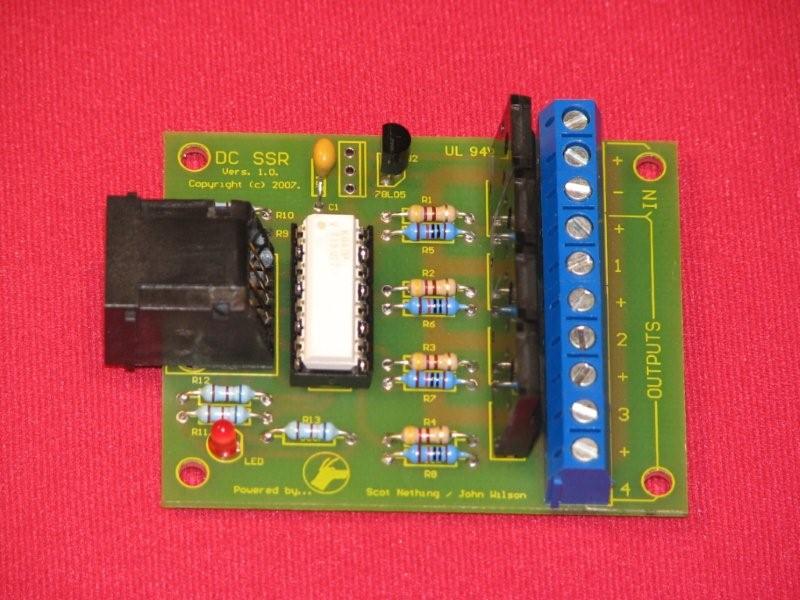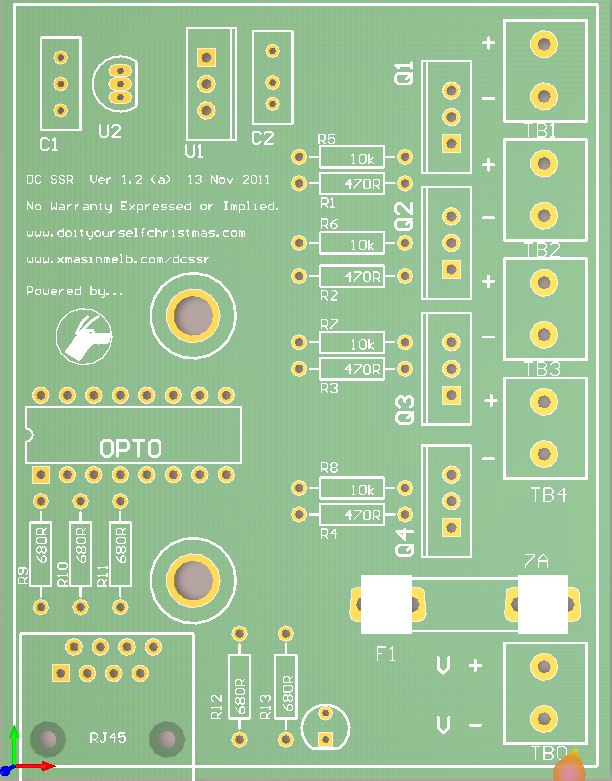4 Channel DCSSR Assembly Instructions: Difference between revisions
| Line 72: | Line 72: | ||
== PCB overaly == | == PCB overaly == | ||
[ | [[File:Overlay.JPG]] | ||
[[Category:SSR]] | [[Category:SSR]] | ||
[[Category:DIYC Index]] | [[Category:DIYC Index]] | ||
Revision as of 12:54, 5 January 2012
Background
The DC SSR project was commenced at the request of Scott Nething, who wanted to control some DC Devices for Halloween. We worked on this project and had some prototype boards working for the shows, and I have subesquently tested the DC SSRs with LED MR16s, and dimmed them using PWM code from a RENARD.
There have been three revisions to the board design.
Version 1.0 original board design (with 78L05 silkscreen errata)
Version 1.1 Original board design with corrected 78L05 overlay)
Version 1.2 Updated board design with Fuse protection and dimensions to fit TA-200 enclosures.
Design
The board is a simple design, and follows the standard connection for an AC SSR COOP board. The RJ45 Socket provides the connection from the DC SSR to the Controller. The LED on the board indicates 5VDC is being supplied from the Controller to the OPTO.
The OPTO, which is different to the MCO3023Ms used on the AC SSR, is a K84PH, 16 pin DIP IC. I purchased mine from Mouser. 782-K847PH was the Mouser Part # and they cost $1.02 each, and here is the Datasheet The OPTO provides DC isolation from the Controller to the DC load. this is a safety feature, though some would suggest it could be deleted, I felt that will storms and electrical noise, it makes sense to isolate the PC and controller from the Lights.
The load switching is provided by MOSFETs.
The original MOSFET used was a STF20NF06 and here is the datasheet. The original MOSFET was plastic tab isolated.
an optional part is the Mouser, RFD14N05L, as part # 512-RFP14N05L and here is the Datasheet
There is a regulated 5V DC supply for the OPTOs, provided by either a 7805 or a 78L05 on the PCB. the PCB has mount holes for the TO-220 or TO-92 case style.
Euro style screw connectors are specificed for the board, and they are grouped in pairs (+/-) to make connections easy.
The DCSSR is designed to switch DC loads between 0 and 30 Volts. The MOSFETs are rated to great than 10 Amps each, however as fitted to the PCB, I would limit to individual channel load to 2 to 3 Amps max. A suitable heatsink will be required.
Schematic Diagram
A DCSSSR V1.1 diagram of the DC SSR is available.
Parts List
The PCB is available from wjohn on the Forum.
511-STF20NF06 4 782-K847PH 1 660-CF1/4C681J 5 660-CF1/4C471J 4 660-CF1/4C103J 4 604-WP7104IT 1 571-5202514 1 863-MC78L05ACPRPG 1 538-39890-0302 5 571-3902614 1 80-C322C104Z5U 1
571-3902614 is an optional IC socket, the rest of the parts are the Mouser part # and quantity required. Click on this link to load a Mouser BOM
Construction Notes
1. When placing the Vreg (863-MC78L05ACPRPG), note that the PCB screen is reversed (PCB v1.0) from the Vreg data spec. Check voltage across the Vout and ground of the Vreg to ensure 5 volts output to avoid damage to the Vreg or MOSFETs.
2. When placing the optional MOSFETs (512-RFP14N05L), note that the tab is conductive and connect to the drain. If the tabs of the MOSFETs touch, extra channels will trigger. Ensure there is space between MOSFETs and do not use a single conductive heat sink across all 4 MOSFETs. In preference, us the original specified part, 511-STF20NF06, which is tab isolated.
Completed DC SSR
Errata for Rev 1.0 PCB
1. The Vreg listed on BOM (863-MC78L05ACPRPG) is correct, the silkscreen is in error. You need to spin the 78L05 180 deg from that shown on the silk screen (flat faces the MOSFET).
2. The MOSFETs listed on BOM (511-STF20NF06) is from the original design. Some DIYC members have used the optional MOSFET, and you need to ensure that the tabs are not touching as they are not electrically isolated.
3. The data sheet for the Vreg on BOM (863-MC78L05ACPRPG) requires an input capacitor as noted in data sheet. the quick fix is to solder a cap across pins #1 and #2 of the 7805 pads, if using the 78L05.

